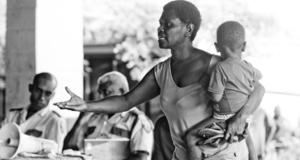Dialogic Conflict and Speech Identity in Jean Rhys' Let Them Call it Jazz
By
2012, Vol. 4 No. 08 | pg. 2/2 | « Early in the story, Selina informs Mr. Sims, “‘I don’t think so much of money. It don’t like me and what do I care?’”20 Though her comment is lighthearted, Selina places herself outside the modern language of consumer capitalism. Sims chastises her for naïveté, insisting that she will end up a “caricature” of herself. In a new modern order that permits social mobility, Selina’s conceptualization of wealth and money constitute an unconventional voice. Though she holds firmly to her patois through the story, Selina does recognize the value of hybridization, itself a modernist trope. After her release from prison, she addresses a woman at the train station with the formality of a well-educated Englishwoman: “‘Yes, I am quite well. But I can’t stand the heat.’ She says she can’t stand it either, and we talk about the weather till the train come in… I know what to say and everything go like a clock works.”21 She overcomes the desire to express herself genuinely, engaging instead in “small talk” about the weather. The dialogized interrelation of languages occurs for her at the personal level as old and new identities come into conflict. She has decoded the narrative system of her new community, familiar enough with “what to say” that she can operate within two distinct speech genres. As she begins to assimilate further into society, “I lie and tell them I work in very expensive New York shop. I speak bold and smooth faced, and they never check up on me.”22 Her narration remains in the same dialect, but she begins to adopt the lies that were previously reserved for those with “quiet voices.” The confidence that has always characterized the prosody of her words is geared now at deception; the “abominable language” she uses early in the story gives way to nicety and the concession that she must sometimes be “sans honte” (without honor). She is, like jazz, a fusion.23As an author, Jean Rhys assumes the same duality. The daughter of a Welsh father and white Creole mother, she could not insert herself into the black community in Dominica, resulting in a “mental condition of double alienation.”24 Like Selina and her other heroines, Rhys embodies the notion of the divided self, with multiple parts in dialogue with one another and that together define a totality or ideologeme (Kristeva). Occupying the space between languages, Rhys is able to utilize and comment upon two sets of verbal processes, creating the “dialogization” through which language norms because “relativized, deprivileged, aware of competing definitions for the same thing.”25 The result is a communalist literature that itself acts as a modernist stew of identities and produces a black-white hybridization of narrative voice.26 Additionally, her voice is distinctly feminine, separate from an essentially masculine semiotic code. Her gendered “otherness” becomes important, too, for her characters: Selina describes herself first in relation to her father, “a white man,” disclosing her identity via negation. “I have his name,” she tells the reader, reminding us of the masculinity of signification (surnames are paternal), only to immediately sabotage this construction by labeling her father a liar (“So perhaps I have not even his real name”).27 Rhys takes on the role of the prose artist in a modernist condition, “elevat[ing] the social heteroglossia surrounding objects into an image … shot through with dialogized overtones.”28 She writes representations of both Creole patois and standard English mindsets, which interact within and without herself. As a result, language codes become less absolute and more fluid; where Selina and her neighbors fail to understand one another, Rhys succeeds, entrenched in both systems of understanding but equipped also with critical perspective. It is from her worldview that the interplay of dialects in the story extends, and from her characters’ collective utterances that the totality becomes a “historical and social text.”29 Ultimately, Selina’s hypothesis that “I don’t think it’s at all like those books tell you” serves also as a warning for the reader. Rhys draws our attention to the indeterminacy of linguistic systems, unearthing conflict between different speech genres and between “word” and “utterance.” The authority of the “symbolic” buckles under the weight of intonation and cultural relevancy. Selina’s distinct narrative vernacular – characterized by lapses in grammar and the unwillingness “to translate Creole words like ‘fout’ and ‘doudou’” – emphasizes her “otherness” within her new system, as well as our “otherness” in relation to her.30 The story places not only characters in dialogue with one another (and themselves), but itself in dialogue with its society and the author in dialogue with the reader. In the modern context of narrative self-consciousness and linguistic complexity, “the very notion of identity is bound up with … the stories we tell ourselves and the stories others tell of us or tell us into,” resulting in a series of signifying systems that, though sometimes taxonomical, offer insight into the entire spectrum of human idiosyncrasies.31 ReferencesAllen, Graham. Intertextuality. London: Routledge, 2006. Bakhtin, Mikhail. The Dialogic Imagination: Four Essays. Austin: University of Texas Press, 1981. Bakhtin, Mikhail. Problems of Dostoevsky’s Poetics. Minneapolis: University of Minnesota Press, 1984. Czarnecki, Kristin. "Jean Rhys's Postmodern Narrative Authority: Selina's Patois in 'Let Them Call It Jazz.'" College Literature, 35.2 (2008): 20-37. Kristeva, Julia. Desire in Language: A Semiotic Approach to Literature and Art. Oxford: Blackwell, 1980. Mellown, Elgin. "Character and Themes in the Novels of Jean Rhys." Contemporary Literature, 13.4 (1972): 458-75. Moore, Judith. “Sanity and Strength in Jean Rhys’s West Indian Heroines.” Rocky Mountain Review of Language and Literature, 41.1 (1987): 21-31. Rhys, Jean. "Let Them Call It Jazz." Tigers are Better-Looking. London: Penguin Books, 1972. Wilson, Lucy. “European or Caribbean: Jean Rhys and the Language of Exile.” Frontiers: A Journal of Women Studies, 10.3 (1989): 68-72. Wylie, Herb and David Pare. “Whose Story is it Anyway? An Interdisciplinary Approach to Postmodernism, Narrative, and Therapy.” Mosaic, 34.1 (2001), 14-19. Endnotes2.) According to Bakhtin, speech genres mark spheres in which language constructions develop stable types, creating communities with a collective (but idiosyncratic) understanding of signifier-signified sets. 3.) Utterance suggests a complete unit of speech, both words/signifiers being utilized and mannerism; words become utterance when they are spoken, or acted, and this sense cannot be distilled into writing, but only represented. 4.) Mikhail Bakhtin, The Dialogic Imagination: Four Essays (Austin: University of Texas Press, 1981), 271. 5.) Mikhail Bakhtin, Problems of Dostoevsky’s Poetics (Minneapolis: University of Minnesota Press, 1984), 201. 6.) Rhys, 44. 7.) Graham Allen, Intertextuality (London: Routledge, 2006), 23. 8.) The subjectivity highlighted by Selina’s narrative voice reminds us of the relationship between ego and body developed in Lacan’s mirror stage; Selina can negotiate her idea of selfhood only in the parallel relationship between language form (or speech genre) and her innate characteristics. 9.) Rhys, 47. 10.) Bakhtin, The Dialogic Imagination, 278. 11.) Rhys, 57. 12.) Bakhtin, The Dialogic Imagination, 278. 13.) Rhys, 56. 14.) Elgin Mellown, “Character and Themes in the Novels of Jean Rhys,” Contemporary Literature 13.4 (1972), 474. 15.) Rhys, 57. 16.) Ibid., 60. 17.) Ibid., 63. 18.) Mellown, 475. 19.) Kristin Czarnecki, “Jean Rhys’s Postmodern Narrative Authority: Selina’s Patois in ‘Let Them Call it Jazz,’ College Literature 35.2 (2008), 20. 20.) Rhys, 49. 21.) Ibid., 62. 22.) Ibid., 63. 23.) This modern cultural hybridization is manifested in modern literature in the multiplicity of possible interpretations, and in the complexity of broad concepts. As Graham Allen states, “If a novelist, for example, uses the words ‘natural’ or ‘artificial’ or ‘God’ or ‘justice’ they cannot help but incorporate into their novel society’s conflict over the meaning of these words” (36). The lies or exaggerations told by the characters in Let Them Call It Jazz function as proxies for greater hegemonic lies upon which systems of race and class relations are constructed. 24.) Lucy Wilson, “European or Caribbean: Jean Rhys and the Language of Exile,” Frontiers: A Journal of Women Studies 10.3 (1989), 68. 25.) Bakhtin, The Dialogic Imagination, 427. 26.) The use of vernacular was relatively popular among modernists like Faulkner and Stein, at once rooted in the realist tradition of Mark Twain and, in Stein’s case, hoping to capture something fundamentally African American. 27.) Rhys, 51. 28.) Bakhtin, The Dialogic Imagination, 279. 29.) Julia Kristeva, Desire in Language: A Semiotic Approach to Literature and Art (Oxford: Blackwell, 1980), 37. 30.) Czarnecki, 21. 31.) Herb Wylie and David Pare, “Whose Story is it Anyway? An Interdisciplinary Approach to Postmodernism, Narrative, and Therapy,” Mosaic 34.1 (2001), 14. Suggested Reading from Inquiries Journal
Inquiries Journal provides undergraduate and graduate students around the world a platform for the wide dissemination of academic work over a range of core disciplines. Representing the work of students from hundreds of institutions around the globe, Inquiries Journal's large database of academic articles is completely free. Learn more | Blog | Submit Latest in Literature |


















